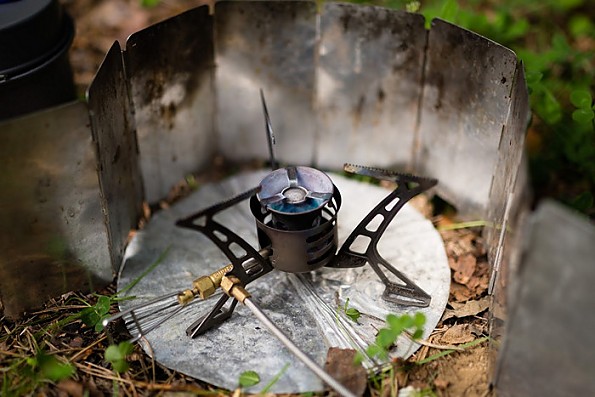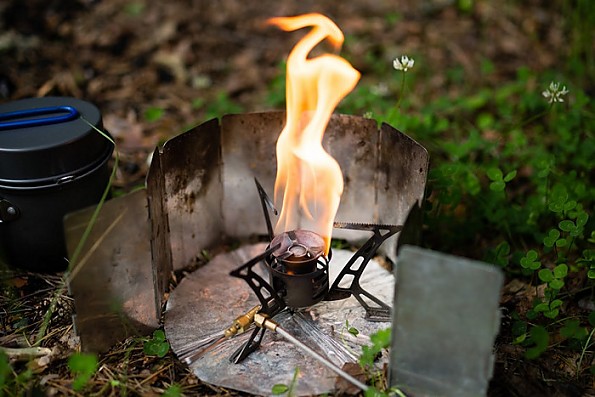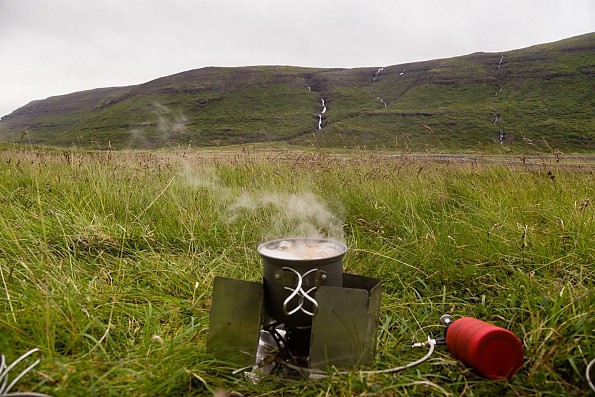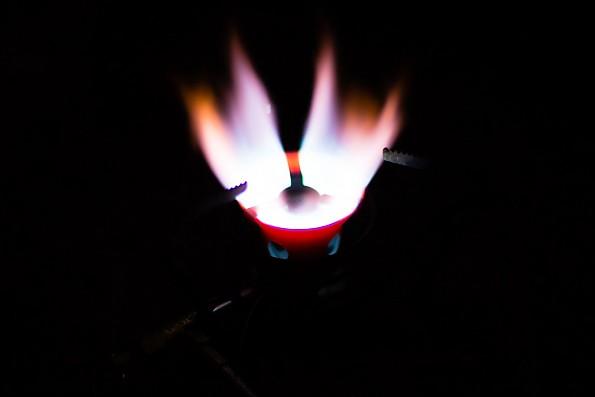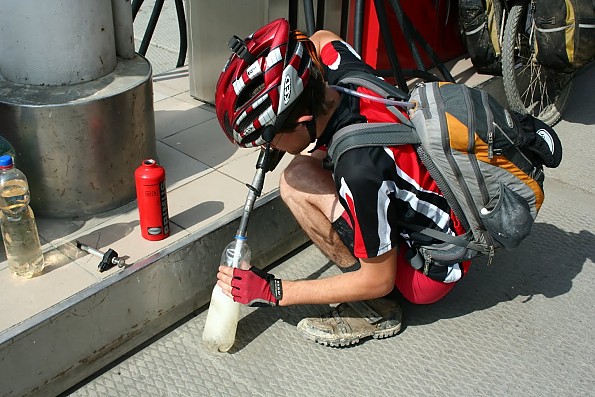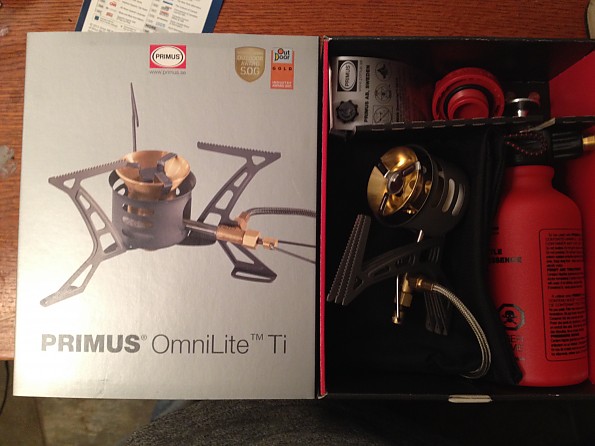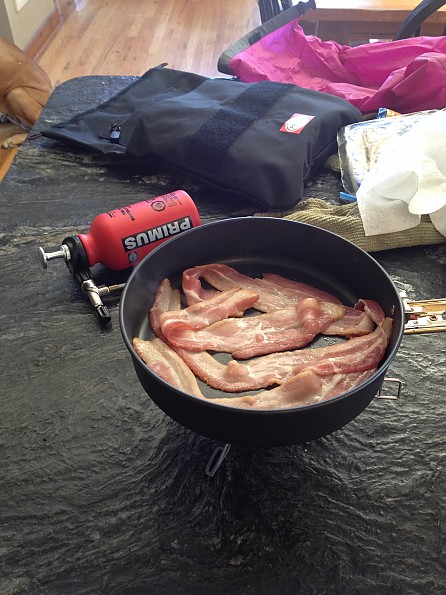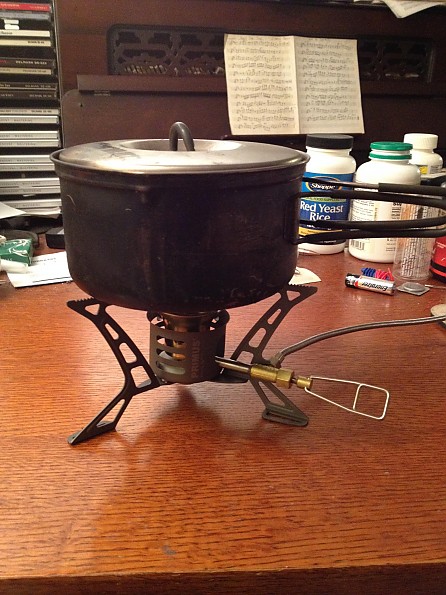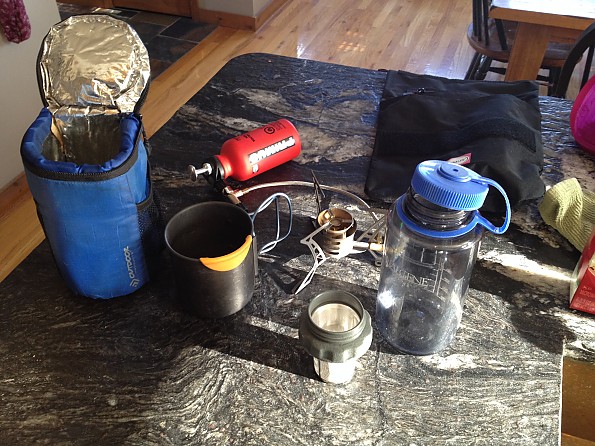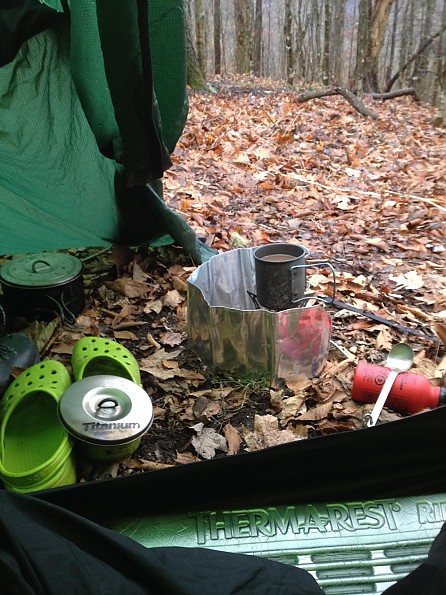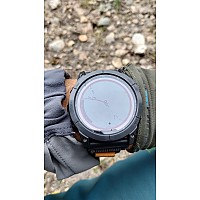Primus OmniLite TI

Lightweight but true expedition-grade stove for use on numerous types of fuel, regardless of the country where you are. In the meantime it’s well suitable for all people who often cook in cold weather and disregard the canister gas.
Pros
- Proven Omnifuel design (just scaled down)
- Expedition-grade durability even for most challenging conditions
- Very low tendency to clogging, easy to clean
- Works well on most fuels you may encounter
- Very small and lightweight for such a stove
- Just 10% less powerful than Omnifuel
Cons
- Awkward, heavy, and useless soft case
- Roaring sound
- Not very durable pump
- No “automatic” cleaning needle
- Fuel sprays when disconnecting the pump from the bottle
I’ve been using this stove since 2013 in all my outdoor adventures. The primary fuel is white gas in domestic trips and car petrol in international trips (for me finding the gas canisters or white gas in unfamiliar country is a waste of precious time). My primary stove in 2008-2013 was Primus Omnifuel, which I liked very much despite its weight and size.
There are two main reasons to use the multifuel stove instead of regular gas stove:
- Performance at low temperatures. If you cook at temperatures below +10 °C (50 °F) and ESPECIALLY below the freezing, the gas stoves are not a good choice for you. Only liquid fuel allows you forgetting about the connection between temperature and stove performance. Have you ever tried to warm the frozen gas canister with almost frozen bare hands to make the gas stove working? The liquid fuel works at all temperatures almost equally.
- Fuel availability. It's easy to find the gas canisters in densely populated areas of developed countries, while there is still some possibility that the necessary shop will be closed, running out of stock etc. But in developing countries and unpopulated areas the only readily available fuel is a car petrol. So if you are planning to travel outside the N. America, Europe, and similar regions, it's a good idea to get the multifuel stove.
The Omnilite Ti is a smaller and lighter version of the well-proven Omnifuel stove. While being very lightweight for a multifuel stove, Omnilite Ti is a true expedition-grade model, suitable for the worst conditions. It has almost no tendency to clogging due to bad fuel quality, and there are only two places which shall be cleaned while working on car petrol: fuel nozzle and the regulator rod. The cleaning is quite straightforward and it requires only included multitool and knife blade.
Unfortunately there is no "automatic" cleaning needle, which simplifies the routine cleaning of nozzle. On the other hand, I've never experienced nozzle clogging since I replaced the stock flame spreader to "silent damper cap".
The included windscreen has a lifespan of about 1-2 years, so the accessory folding windscreen (a smaller one), which is seen on my photos, is a great addition to this stove.
The stove is quite effective, and it warms up quickly (while doing so may be not so easy for inexperienced users — just follow the manual). To conserve the fuel, it's strongly advised to use about 75% of power. For fuel conservation I don't use large pots: before 2016 my favorites were 1L aluminum (on photo above) and 1.5L stainless steel pots. For better fuel conservation in 2016 I bought two Primus pots with heat exchangers - 1L ETA Pot (on photo below) and 1.8L Primetech Pot.
The stove is very good at simmering, where the stable power output is comparable to a cigarette lighter. The included 0.3L bottle is more than enough for 2-3 people in short 2-day trips. In full-scale trips I still use the small bottle, because it takes very little time to pump it up. My old 1-liter bottle is used only as a fuel storage. Also the spare fuel may be taken in regular plastic bottles, but on some petrol stations filling the petrol to plastic bottles is prohibited.
The list of important disadvantages is pretty short. First, the included storage bag is awful: it is gigantic, heavy and offers no protection for the delicate stove hose. Use the Chinese neoprene accessory bag for storing your stove inside the pot. I have no idea for possible use of that Primus bag.
Second, the Primus pump is not a state of art. Even if lubricated regularly, after a year of use it begins losing its efficiency. After 2-3 years of frequent use the rotary plastic knob with thread and fuel valve tends to stuck. What is worse, sometimes there are fuel leaks in old pumps (the pump barrel becomes loose in plastic bottle cap) — just report to Primus directly, and they may send you a new pump.
Unfortunately, you cannot disconnect the stove from the pump without depressurizing the bottle. The correct way to do this (by turning the bottle upside down while burning) is long and it consumes fuel. Usually I partially unscrew the pump from the bottle, and in this moment the fuel-air mixture bursts in the air. There are some stove designs which avoid it, but the Primus is a bit more old-school.
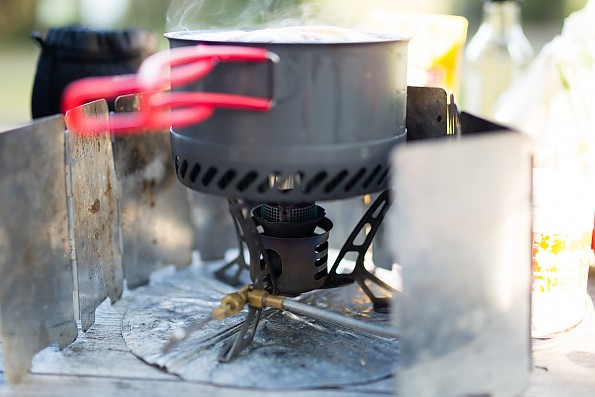
(with Quietstove silent damper cap)
This stove is roaring. Not as much as Omnifuel, but still quite noticeable. For those who dislike the roaring stoves I’d personally recommend the silent damper cap from Bernie Dawg (cheaper, better design, but no warranty and money back) or Quietstove (with lifetime warranty and money back). I own the latter and I’m pretty satisfied with it. The fuel burns even more effectively, and the roaring is gone for good. But the stove heat-up takes more time. I've never used the genuine Primus silencer, but the forum folk say that its design is terrible.
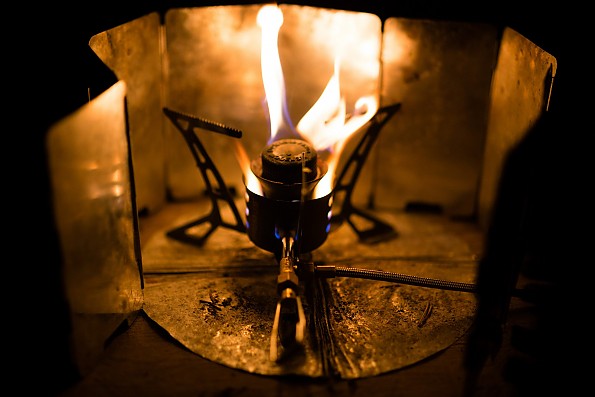
(with Quietstove silent damper cap)
In conclusion, the Omnilite Ti is very nice addition to Omni model line, and may be recommended to all outdoor enthusiasts who wants to cook for 2-3 persons on all kinds of fuel. You may look at Omnifuel only if you often cook for 4 and more people at once.
BTW, if you ever go to Russia, ex-USSR countries or S.Korea, don’t forget to purchase the bayonet canister gas adapter — such type of gas is very popular there (it’s cheap but stops working below freezing temperatures).
Source: bought it new
Price Paid: 150$
Fantastic stove. Comes in a stupid, ill-conceived synthetic bag.
Pros
- Lightweight
- Reliable
- Burns nearly any fuel
- Simmers well
- Easy to use
Cons
- The included storage bag is big, bulky, heavy
- The bag offers little real protection of the stove
When I first got the Omnilite Ti stove I tried several fuels just to see how they worked, but knowing all along that after testing I would most likely never use anything other than white gas.
It is nice to know that in an emergency one could siphon regular unleaded, AVGAS, Jet A, etc. from a vehicle or downed aircraft. Kerosene could be pressed into service and I did try diesel once. I also tried isobutane canister, although if I wanted to use canister stove I'd always still choose my old trusty Snow Peak GigaPower (auto), which is still my favorite summertime lightweight backpacking stove.
But canisters don't work reliably in extreme cold and extreme altitudes. When the chips are down, along with the temps, white gas is king.
I have zero complaints with the stove itself. It has been reliable. It simmers. It roars. It works like a champ. It is my go-to for winter camping.
The stove is light. The legs are stable. The pot sits stable on the stove. The supplied 1/3 liter fuel bottle is perfect in every way and the pump is well built. It comes with a foldable aluminum heat shield and wind screen.
I'm one of those people who is not bothered by the roar of white gas stoves. Maybe because my first exposure was the Optimus Svea 123 (which by the way, I've had for 35 years and it still works!).
But back to the subject of reviewing the Omnilite Ti,....I have only one complaint. I hate the storage bag!
It is made of some heavy nylon-like material, fashioned as a very large envelope with a velcro flap/cover. The flap has an inner pocket suitable for storing the paper booklet "Owner's manual" along with the wind screen and heat shield.
There is a smaller zippered pocket for storing the various jets needed for respective fuels. The main pocket contains the stove, the included 1/3 liter fuel bottle, and it has enough room left over for a spare 12 or 16 oz fuel bottle. OK, cool. That all sounds reasonable. But it is an inefficient use of space. The bag is too big, too bulky, and it wastes a lot of volume in a pack.
If the idea of a storage container is to PROTECT the stove then it does little in that regard. Dropping the pack or sitting on it could potentially bend the legs of the stove just as easily as if the stove were packed without using the storage bag at all. There has to be a better way. I am on the lookout for an alternative container for the stove.
I think the bag is so stupid it deserves no stars. The people who made the decision to include the bag should be fired. But it's not the stove's fault! It is a 5 star stove!
Source: bought it new
Price Paid: I don't remember exact price. It has been three years. I think about $160.
Pros
- Very light
- Compact
- Stable
- Good pump
- Easy to maintain
- Good simmer control
- Good build quality
Cons
- Long pre-heat
- Noisy
- Expensive
As an expedition stove for backpacking where every gram counts, this is hard to beat. The titanium construction makes it feel sturdy despite the low weight.
Used mainly for motorcycle camping this weight saving is not as critical. Boil times and consumption are good typical of this kind of stove.
The pump being of metal construction feels solid and effective, though mine is still relatively new. Time will tell.
Maintenance is easy using the tool provided and this includes a pricker for clearing clogged jets unlike the Optimus Polaris where this is achieved by waving the multi-tool under the burner. And unlike the Polaris, the jets have to be changed for each different fuel though this is unlikely to happen often and is very easy.
The only tradeoffs come with the noise level which is quite high and can be intrusive in a crowded campsite. This can be overcome with the silent burner supplied by Primus. This not only reduces the noise significantly but improves even more the already good simmer control.
The disadvantage with this is that it is not recommended for use with fuels other than canister gas and white gas, though I tried mine with kerosene after pre-heating with alcohol and it seemed OK. The silent burner also increases the already long pre-heat time and adds significantly to the cost of what is already a very expensive stove.
The pre-heat process can also result in big flames initially and for this reason I am reluctant to light it in a tent vestibule. Wind protection is essential during pre-heat as even a slight breeze can effect this process greatly. The pre-heat pad does disintegrate eventually so I carry a spare.
The storage bag is much too bulky and I have never used it. Instead I put it in a neoprene lens case and it all fits in my Zebra 14cm lunch box cooking pot.
That said I am generally impressed with this stove, though for motorcycle camping and sheer convenience and ease of use I find myself using the much cheaper but slightly heavier Coleman 442 more and more.
Source: bought it used
Price Paid: £110
Your Review
Where to Buy
You May Like
Accessories: Primus StovePaw,
Specs
| Price |
Historic Range: $179.96-$249.99 Reviewers Paid: $150.00 |
| Fuel |
gas, gasoline/petrol, diesel, kerosene/paraffin, aviation fuel |
| Boil time for 1 L of water |
2:40 minutes (+ preheating 40 sec) with PrimeTech Pot |
| Weight |
341 g / 8.4 oz (with fuel pump), 239 g / 12 oz (without) |
| Dimensions |
170 mm / 6.7 in (cooking base), 115 x 90 x 55 mm, 4.5 x 3.6 x 2.2 in |


